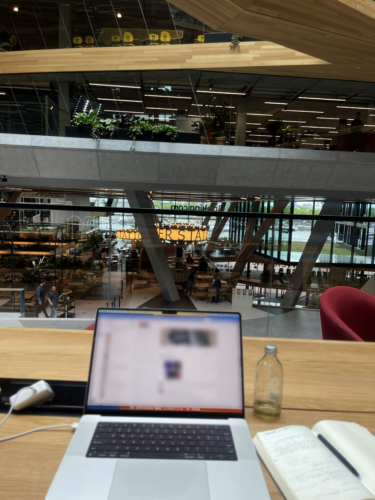Richard Omollo gives insights into his work as a UX designer at booking.com.
In our latest interview, Omollo, UX design leader in the FinTech Business Unit at Booking.com, talks about how UX design helps to build trust in the FinTech industry. Interview by Daniel De la Fuente, Service Design Lead at George Labs.
With a wealth of experience and expertise, Richard brings a unique blend of creativity, strategic thinking, and leadership to his role. Richard has a strong understanding of the unique challenges and complexities within the financial technology landscape.
In this interview, we discuss Richard’s journey into the UX design world, his thoughts about the evolving industry, and the key skills that every UX designer needs to know.
Q: First things first: Where are you based? And what does a typical morning in your life look like?
A: I alternate between working from home and the newly opened Booking.com campus in Amsterdam, which is really cool. You should check it out. I look forward to my mornings because I get to start the day with my son and prepare him for school. We have breakfast together, and I enjoy my coffee without sugar or milk. Depending on the weather, we either walk or bike to school. When going to the office, I use public transportation and utilize the 45-minute commute to plan my day. Alternatively, when working from home, I spend the first 45 minutes to 1 hour planning my day.
Q: Explaining a little bit about what the Booking.com fintech team is, who’s behind it, and since when.
A: At Booking.com, our mission is to make it easier for everyone to experience the world and part of this is to provide seamless payment experiences for our guests and partners. Within our Booking, the FinTech business unit is dedicated to creating top-notch payment & financial products that offer a range of options to guests and support the growth of our partners. This business unit has evolved over the past three years, starting as the payments department before transitioning into a fully-fledged business unit one and a half years ago. Leading this unit is our Senior Vice President of FinTech, Daniel Marovitz.

View from inside Booking.com’s Campus in Amsterdam
Q: Before joining Booking: Were you familiar with the travel business at all? If not, how long did it take you to understand the market needs?
A: No, I did not! And that’s one of the things I love about working here. My colleagues were so patient with me, they held my hand when I joined until I was comfortable enough to keep up with others. I would say it took me around 6 months to become productive and another 6 months to become efficient.
Q: Now more than ever, we’ve seen a lot of generic designs/generic applications. How do you keep up and stand out with a unique experience?
A: I believe that in a competitive market, one of the key differentiating factors is the experience that accompanies your offering. Thus, we must stay focused on the goal of our designs and solve the problem at hand or help users to achieve their goals. As designers, it is crucial for us to sell the user experience and stay ahead of the curve. This is where competitor analysis comes into play. However, it’s important to note that what works for others may not necessarily work for you. Therefore, gathering feedback from users through feedback loops is crucial to ensure you are meeting their needs effectively.
Q: In which position do you see the design team in your company (in terms of the design maturity ladder)?
A: I’m genuinely pleased with the progress we’ve made, especially with the implementation of Functional Craft Reporting (FCR). FCR enables individuals to report to managers within the same craft, promoting collaboration and inclusion at all levels. Designers, for instance, report to Design managers, who report to Senior Design managers, and so on up to the VP level. This approach fosters a more integrated, structured, and customer-focused organization overall.
Q: During our design conference George UX Conf, we’ve discussed the topic of design maturity and the importance of having someone at the C level. How far are you from getting there?
A: Our focus is on building an organization that is customer-centric in all aspects. From my perspective, having a designer at the C level can greatly influence the direction of the company by driving design-led innovation and emphasizing customer-centricity and empathy in decision-making. Design leaders at this level can effectively enhance customer experiences, integrate design practices across functions, and demonstrate the tangible business value that design brings. Ultimately, having a designer at the C level elevates the strategic importance of design, resulting in a competitive advantage, increased customer satisfaction, and positive societal impact.
Q: Trust is a very relevant aspect for all of us working for finances, how do you tackle these core needs from a UX design and business perspective?
A: Indeed trust, clarity, and transparency are very relevant to everyone in the industry. Based on my experience in finance, three important questions contribute to building trust in the FinTech world: Who? When? and How? Whether you are making a payment, expecting a refund, or engaging in any financial transaction. It’s important to help people identify who they are paying or who is paying them. Making it clear when and how that payment is happening is equally important. For example, with the rise of Buy Now Pay Later (BNPL) services, it becomes crucial to understand when sellers will be receiving payment or when customers are expected to make payments. Lastly, it is essential to consider how people are supposed to pay and how sellers will be receiving payments.
“Clarity on this topic, among others, should be a key factor when designing financial experiences. By addressing these questions and providing clear information, designers can contribute to establishing trust and ensuring smooth interactions in financial transactions.”
Don’t miss the George UX Conf 2023 if you’re interested in learning more about UX themes in the financial business. Read about the conference in the latest blog here.


